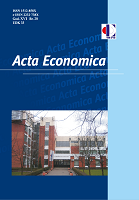ОТВОРЕНОСТ МАЛИХ ТРАНЗИЦИОНИХ ПРИВРЕДА – ПОСТКРИЗНА РЕВИДИРАНА АНАЛИЗА
OPENNESS OF SMALL TRANSITIONAL ECONOMIES – REVISED ANALYSIS AFTER THE GLOBAL ECONOMIC CRISIS
Author(s): Jelena TrivićSubject(s): Economic policy, International relations/trade, Economic development
Published by: Економски факултет Универзитета у Бањој Луци
Keywords: openness to trade; import; export; economic development; small economies;
Summary/Abstract: The influence of the economy’s openness on overall economic growth and development is a widely explored topic among economists with still unclear conclusions. They mainly stem from different ways of measuring the degree of openness of countries. In this paper the openness of the economy towards foreign trade is seen as a share of the amount of import and export of goods in the gross domestic product. A particularly interesting issue is the connection between openness and economic development in the case of small open economies, which in principle are “condemned” to greater openness. The subject of this paper is an analysis of the relation between the country’s openness to foreign trade and economic development on a sample of 23 small and transitional economies. The sample examining the relationship between openness and economic development is based on the Transition Report of the European Bank for Reconstruction and Development with the exclusion of some countries that, according to the definition of a small country in this paper, are not considered small countries. A small economy in this paper is defined as a country whose policy on the world market does not affect the formation of world prices, i.e. it is a price taker, and this general part of the definition is based on the definition of a small economy that can be found in Deardorff ’s Glossary of the international economics. For a more precise definition of a small economy, we have adopted an additional threshold according to which a small country is considered to be a country whose share in the world exports and imports does not exceed 1%. In this paper, a method of correlation between variables is used to determine the nature of the relationship that exists between openness and economic development of economies. Economic development is measured by gross domestic product per capita measured by purchasing power parity. It was examined what the nature of this relationship is, and whether there is a difference between the relationship of exports and economic development and the relationship of imports and economic development. The results of the research suggest that outward orientation has no alternative in the case of small open economies, but for small economies it is extremely important to distinguish foreign trade flows from import and export when considering the degree of their openness. This implies that the results of the analysis have shown there is a much stronger positive correlation between openness measured by the share of exports in GDP and economic development than between openness measured by the share of imports in GDP and economic development, although the latter relation is also positive. The results of the analysis point to the conclusion that export performance of small open economies, which they base the growth of the living standard of their population on, is of the highest importance for them.
Journal: Acta Economica
- Issue Year: 16/2018
- Issue No: 28
- Page Range: 55-71
- Page Count: 17
- Language: Serbian

